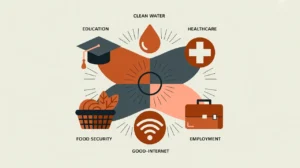Importance of Causal Loop Mapping
Causal loop mapping is a method for visualizing the feedback loops that shape system behavior over time. It matters because many social, economic, and environmental challenges are driven by reinforcing or balancing dynamics that are not immediately visible. By making these loops explicit, causal loop mapping helps practitioners understand why problems persist, where unintended consequences arise, and how interventions might produce lasting change.
Definition and Features
Causal loop mapping is the process of diagramming cause-and-effect relationships within a system using loops to show feedback. Its defining features include:
- Feedback Emphasis – distinguishes between reinforcing loops (which amplify change) and balancing loops (which stabilize systems).
- Directional Arrows – uses positive and negative links to show the nature of relationships.
- Dynamic Insight – reveals how small changes can escalate or dampen effects over time.
- Participatory Utility – often developed collaboratively to capture diverse understandings of causality.
- Learning Tool – serves as a foundation for more advanced systems modeling and scenario planning.
How this Works in Practice
In practice, causal loop mapping might chart how unemployment leads to reduced household income, which lowers demand for goods, which in turn reduces job opportunities, forming a reinforcing loop. Another example could show how improved education reduces poverty, strengthens health outcomes, and supports educational attainment, all within a positive cycle. Practitioners may use whiteboards, software, or participatory workshops to build causal maps. Challenges, however, may include oversimplification, difficulty in validating causal assumptions, and the need to revisit maps as conditions evolve.
Implications for Social Innovation
Causal loop mapping contributes to social innovation by revealing the hidden engines of system behavior. For practitioners, it identifies where interventions can break vicious cycles or strengthen virtuous ones. For funders and policymakers, it offers a tool for anticipating ripple effects and designing more adaptive strategies. A causal loop map can become a shared language. It can help diverse stakeholders grasp complexity and collaborate on solutions that address root dynamics rather than surface symptoms.







